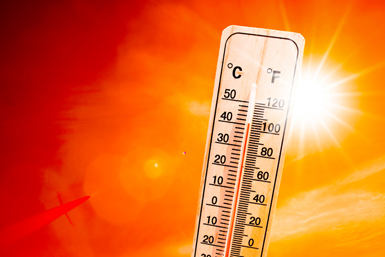
With large swaths of the South, Midwest and West currently feeling the effects of a major heat wave, and as seasonal temperatures continue to rise as ag pilots enter the height of their flying seasons in July, it’s important to take precautions to protect yourself and your crew from heat stress.
As certified physician assistant Brittany Kerr explained in Agricultural Aviation magazine, heat-related illnesses are most common from May to September, reaching their peak in July. These illnesses include sunburn, heat cramps, heat exhaustion and the most severe, heat stroke. The most common risk factors for developing a heat-related illness include strenuous physical activity in high heat and humidity, lack of acclimation, poor physical fitness, obesity, dehydration and carrying a large external load (such as clothing, equipment and protective gear).
One of the first signs of a heat-related illness is muscle pain or spasms in the legs, abdomen and arms. It can be easy to mistake those leg cramps as a natural part of flying and working rudder pedals all day. As these heat cramps progress, you can develop more severe symptoms such as nausea, vomiting, heavy sweating, tiredness, headache or dizziness. Taking a break to spend some time in a cool place and rehydrating with water or an electrolyte-rich drink (i.e., Gatorade, Powerade) are vital to helping your body recover. Electrolytes are a key factor here, as they provide sodium and other elements your body’s muscle cells need to function properly. Relaxing, stretching and massaging the affected muscle are all excellent strategies for alleviating discomfort.
The most serious stage of heat illness is heat stroke. When your body reaches this point, your internal temperature is as high as 104 degrees or above. The body loses its ability to cool down, and the temperature continues to rise. The skin will be red and hot. Your pulse will be fast and strong, almost as if it’s pounding out of your body. Nausea, confusion and even unconsciousness can develop. At this point, you need to SEEK MEDICAL ATTENTION IMMEDIATELY! In the most severe cases, this can lead to permanent disability or death.
In all of the above scenarios, hydration is a critical factor in maintaining wellness and ensuring you’re in prime operating condition. The body is made up of 60% water. When dehydrated, you can lose 1 to 2% of that volume rapidly. That doesn’t seem like a lot, but to the mix in your body, that sort of change can cause increased stress, agitation and memory issues. Body water loss means you’ve also lost electrolytes. Aside from dry mouth and dry skin, you can also experience low urine output, rapid breathing and even chest discomfort—all related to the electrolytes you are lacking from low water volume. It’s recommended that men drink 15.5 cups of water per day and women 11.5 cups per day—but this need increases in times of water loss, including heat exposure. For every degree your body temperature goes over 98.6 degrees, you should add at least a half cup.
Aerial applicators take great care to make sure that their aircraft, pumps and other equipment are in working order. Paying attention to your physical health is also imperative, especially as you push yourself hard during these busy summer months.
OSHA-NIOSH Heat Safety Tool App
The OSHA-NIOSH Heat Safety Tool is a free app that may be worth getting. It has a real-time heat index and hourly forecasts specific to your location. It also provides occupational safety and health recommendations from OSHA and the National Institute for Occupational Safety and Health.
The OSHA-NIOSH Heat Safety Tool features:
-
A visual indicator of the current heat index and associated risk levels specific to your current geographical location.
- Precautionary recommendations specific to heat index-associated risk levels.
- An interactive, hourly forecast of heat index values, risk levels and recommendations for planning outdoor work activities.
- Location, temperature and humidity controls, which you can edit to calculate for different conditions.
- Signs and symptoms and first aid guidance for heat-related illnesses.